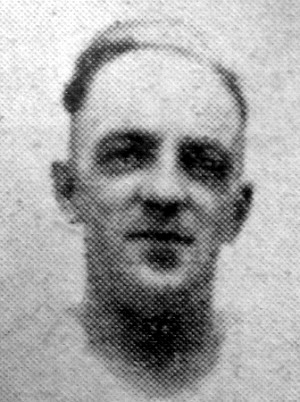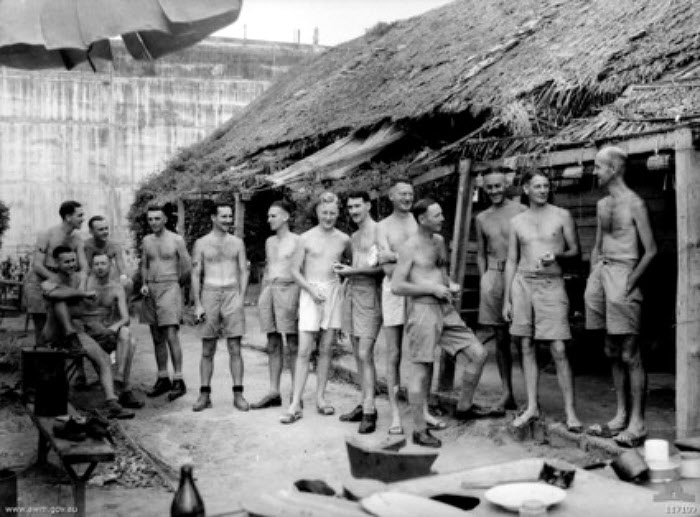
Arnold Horton was born in Ossett on the 19th April 1913, a twin born to Joseph Henry Horton and Beatrice Lillian Haigh, who married in the Dewsbury area in late 1912. In 1911, Ossett born joiner, Joseph Henry Horton, aged 24 years, was living with his uncle, Harvey Westwood, at Church Street, Ossett. In the same year, 22 year old, Beatrice Lillian Haigh, a rag grinder, the youngest daughter of three, was living at Happy Land, Ossett with her parents and three surviving siblings. They were all born in Ossett.
In September 1939, Arnold, aged 26 years and a general labourer was living at 5, Happy Land, Ossett with his twin sister, Nora, a confectionary shop assistant and their widowed mother Beatrice . The twins’ father, Joseph Henry died in early 1929 aged 42 years.
After Arnold Horton had completed his training as a signalman after joining the Royal Signals in 1940, he was shipped out to Singapore and joined the Fortress Signals Unit on the island. The Japanese invaded the island in February 1942 and easily overcame the British defences, despite the fortress reputation of Singapore. Arnold Horton was unfortunate enough to be captured by the Japanese and had to march the 18 miles to Changi on the eastern tip of the island of Singapore to the prisoner of war camp there.
Changi was one of the more notorious Japanese prisoner of war camps and was used to imprison Malayan civilians and Allied soldiers. The treatment of POWs at Changi was harsh, but fitted in with the belief held by the Japanese Imperial Army that those who had surrendered to it were guilty of dishonouring their country and family and, as such, deserved to be treated in no other way. For the first few months the prisoners of war at Changi were allowed to do as they wished with little interference from the Japanese. There was just enough food and medicine provided and, to begin with, the Japanese seemed indifferent to what the POW’s did at the camp. Concerts were organised, quizzes, sporting events etc. The camp was organised into battalions, regiments etc and meticulous military discipline was maintained.
However, by Easter 1942, the attitude of the Japanese had changed. They organised work parties to repair the damaged docks in Singapore and food and medicine became scarce. More pointedly, the Japanese made it clear that they had not signed the Geneva Convention and that they ran the camp as they saw fit. Before much of the harsh treatment of prisoners of war occurred, Signalman Arnold Horton had succumbed to dysentery and had died in late April 1942. His widowed mother Beatrice had to wait nearly four years in the hope that her son was still alive before she learned of his fate.
The “Ossett Observer” had this obituary for Arnold Horton:1
“Soldier’s Death In Far East – Signalman A. Horton, Ossett – Official information has now been received that Arnold Horton (28), Royal Corps of Signals, son of the late Mr. Joseph Henry Horton, 7 Park View, Station Road, Ossett, died whilst a prisoner of war in Japanese hands in February 1942. He was reported missing after the fall of Singapore and later posted as missing, but about four years have elapsed since his mother heard from him last.
He was unmarried and before entering the Army lived at home with his mother. His maternal grandfather was Mr. George ‘Happy’ Haigh, who served 28 years in the old Volunteer Corps, and his father, who was engaged with Messrs. McAlpine building Army huts in France in the last war died 16 years ago. Horton was educated at Holy Trinity school and attended the Central Baptist Sunday School. He was employed by Mr. Clifford Moiser, greengrocer, for seven years, and before joining up in July 1940, was with Langley Brothers.
On Tuesday last, his mother received a letter from a captain in the Royal Signals stating: ‘ Singapore Fortress capitulated on February 15th 1942, and two days later the whole of the fortress Signals unit, of which I was adjutant, marched to Changi Prisoner of War Camp at the east end of the island. There we settled down quickly to a comparatively happy life. We rarely saw the Japanese and in those early days there was no question of ill-treatment. The food was less than normal, but sufficient. We were, however, rather crowded together, and, when in that state, we were hit by a dysentery epidemic. Your son was taken ill and we rushed him to the Roberts hospital. There he received all the treatment possible from British doctors and R.A.M.C. orderlies, but they were unable to save him, and he died on April 15th 1942. He was in no pain when he died. He was given a military funeral at Changi Cemetery and his grave is No. A. C. 1. With you, myself and the rest of his unit who came through the three and half years mourn the loss of a good comrade. His devotion to duty during the campaign had put him in the forefront and his unselfishness during the few weeks he lived as a prisoner of war was outstanding. In him we lose a great soldier and an even greater man.’ The letter concluded with an expression of the greatest sympathy.”
Arnold Horton died on the 15th April 1942, aged 28 years and is buried at grave reference 8. C. 1. in Kranji War Cemetery, Singapore. Kranji War Cemetery is 22 kilometres north of the city of Singapore, on the north side of Singapore Island overlooking the Straits of Johore.
Before 1939, the Kranji area was a military camp and at the time of the Japanese invasion of Malaya, it was the site of a large ammunition magazine. On 8 February 1942, the Japanese crossed the Johore Straits in strength, landing at the mouth of the Kranji River within two miles of the place where the war cemetery now stands. On the evening of 9 February, they launched an attack between the river and the causeway. During the next few days fierce fighting ensued, in many cases hand to hand, until their greatly superior numbers and air strength necessitated a withdrawal.
After the fall of the island, the Japanese established a prisoner of war camp at Kranji and eventually a hospital was organised nearby at Woodlands.
After the reoccupation of Singapore, the small cemetery started by the prisoners at Kranji was developed into a permanent war cemetery by the Army Graves Service when it became evident that a larger cemetery at Changi could not remain undisturbed. Changi had been the site of the main prisoner of war camp in Singapore and a large hospital had been set up there by the Australian Infantry Force. In 1946, the graves were moved from Changi to Kranji, as were those from the Buona Vista prisoner of war camp. Many other graves from all parts of the island were transferred to Kranji together with all Second World War graves from Saigon Military Cemetery in French Indo-China (now Vietnam), another site where permanent maintenance could not be assured.
The Commission later brought in graves of both World Wars from Bidadari Christian Cemetery, Singapore, where again permanent maintenance was not possible.
There are now 4,461 Commonwealth casualties of the Second World War buried or commemorated at Kranji War Cemetery. More than 850 of the burials are unidentified. The Chinese Memorial in Plot 44 marks a collective grave for 69 Chinese servicemen, all members of the Commonwealth forces, who were killed by the Japanese during the occupation in February 1942.

Above: Changi Prisoner of War Camp, Singapore, WW2.
References:
1. “Ossett Observer”, 24th November 1945.